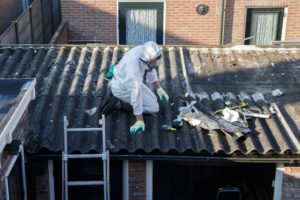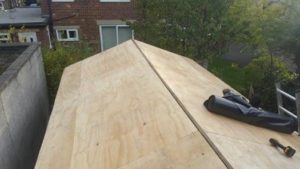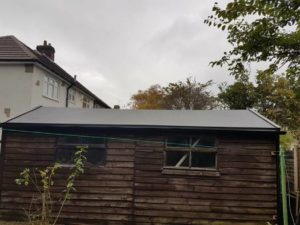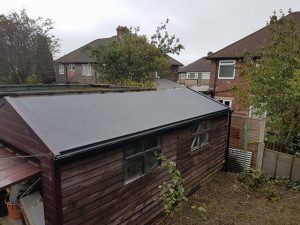It’s not uncommon for garage roofs to be made from materials containing Asbestos. We are experts in removing and replacing asbestos roofs with our weather-resistant, cost-effective and safer EPDM rubber flat roof. Whether your garage has a leak, is corrugated or not, we’ll ensure the Asbestos is safely disposed of and that your garage is restored. Flat Roof Experts are known throughout Bradford and the Yorkshire Area as a trusted high-quality roofing solutions company.
Advantages of Removing Asbestos Roof
We promise a structured approach to removal. We’ll firstly inspect and analyse your garage roof. We’ll also provide you with a fixed cost for abstraction and the replacement EPDM rubber roof, which has a 20-year guarantee. We’ll then commence your Asbestos roof removal, which involves spraying PVA water on the contaminated area and enclosing the hazardous materials in polythene sheeting. The garage and surrounding area are then decontaminated with a Category H vacuum and you’ll receive a consignment note as proof. We’ll ensure the safe disposal of your garage roof too.
The Benefits of Removing Asbestos include:
- Prevention of serious medical conditions, some of which currently have no cure.
- Prevention of airborne Asbestos in cases of floods, fires or other natural disasters.
- Prevention of Asbestos spreading to other areas of the home.
The Benefits of our EPDM Rubber Flat Roofs include:
- Durability due to wind, water and UV Rays unaltering strength.
- Clever design, expanding and contracting with changes in temperature.
- Cost-effective and requires little to no maintenance.
FAQs
Asbestos is a naturally occurring mineral that was widely used as a building material in the 20th century due to it being cheap, durable, incombustible, heat-resistant and sound-absorbent. The use of asbestos peaked in the 1970s and 1980s and was used extensively in roofing and insulation in both residential and industrial buildings. Cement sheets were one of the most commonly-used roofing products containing asbestos, particularly for garage roofs. However, due to conclusive research into its deadly health risks, the use of asbestos has since been banned in the UK. That doesn’t mean there aren’t still buildings out there with asbestos roofing, though.
Despite it once being commonplace in the construction industry, asbestos poses a serious threat to our health. When a product containing asbestos is disturbed or damaged, it releases tiny but deadly asbestos fibres into the air. When inhaled, these fibres remain permanently lodged in the lungs, causing soreness, inflammation and infection. Left untreated, asbestos inhalation can lead to a range of dangerous illnesses including lung cancer, pleural thickening and mesothelioma.
The statistics around asbestos-related deaths are alarming. Asbestos is responsible for killing around 5,000 people every year while 20 tradesmen die each week due to past exposure. It can take between 20 and 50 years for the effects of asbestos inhalation to take hold, making it a silent killer. Unfortunately, if you’re a smoker who’s come into contact with asbestos, you’re at a significantly higher risk of contracting lung cancer.
If your roof happens to contain asbestos, removing it protects you, your family and your neighbours from the dangerous diseases associated with the material. It also prevents asbestos from spreading throughout your home — it’s been known to seep into roofing felt, gutters and vinyl floor tiles, amongst other places. Asbestos was banned outright in the UK in 1999. However, many buildings that were constructed before the year 2000 still contain asbestos and pose a health risk if they’re damaged or disturbed.
Asbestos is extremely dangerous and hazardous to health. The use of asbestos has been banned in all building structures in Britain, and in 60 other countries across the world since the year 1999. Still to this day, it is believed that approximately five thousand workers die as a result of previous exposure to asbestos – exposure as far back as the 70s and 80s.
Exposure to airborne particles from asbestos can cause a number of life-threatening diseases. It can cause mesothelioma, which is a cancer of the lining of the lungs and stomach. It may also cause scarring of the lungs known as asbestosis, lung cancer and widespread pleural thickening.
If you own a commercial property you have a legal obligation to remove any asbestos roofing that is present. A professional asbestos removal service will collect and transport the asbestos to a licensed asbestos disposal facility, where it will be disposed of safely and in line with environment agency regulations.
You can then replace the asbestos with a much safer, cost-effective and protective solution, like EPDM rubber roofing. This is a synthetic rubber created from oil, natural gas ethylene propylene and diene. The latter is a hydrocarbon that contains two double carbon bonds. The material is non-toxic and completely safe to all lifeforms.
Any property built before 1999 may contain some traces of asbestos, especially if they are still standing and have not been properly renovated for some time. Before we properly understood the associated risks and dangers of asbestos, the material was widely used in construction due to its availability, cheapness and versatility.
Asbestos cement is a mixture of mainly white asbestos and cement. The material is moulded and flattened to create a variety of asbestos cement products, which can be used as roofing materials. This is more commonly used in commercial properties rather than residential ones, as the material can also be used for cladding, flues, downpipes and gutters.
When it comes to residential properties, asbestos is commonly found on the roofs of smaller outdoor buildings, like sheds and garages. Asbestos garage removal is just as important as removing the material from your main abode or commercial property. Sometimes, the material can be found within the structure of your property rather than just on the roof. You may also find it in your floorboards, wall coatings and attic space too.
If you are unsure whether or not asbestos is present on your property you should seek professional help and advice. The removal of asbestos roof sheets should only be conducted by a trained and experienced professional, do not attempt to investigate or remove the material yourself.
Once the asbestos has been removed, you can then look at replacing it with a safer, more protective material. EPDM rubber roofing does not pose any harm or threat to your health, and it provides a cost-effective solution for your roof with very little maintenance required.
Why choose Flat Roof Experts for your Asbestos Roof Removal and Replacement
For nearly 20 years, we’ve been providing Bradford and the Yorkshire Area with high-quality roofing solutions. We have built up a reputable business that caters to the specific and unique needs of our clients and we’ve always had the expertise to deliver.
We are a family-run business, putting emphasis on values such as good service, effective materials and customer satisfaction. We’ve also developed wonderful working relationships with our customers, clients, surveyors and installers.
Professional Asbestos Roof Removal and Replacement
Many older structures had asbestos roofs traditionally installed on the likes of garages, storerooms and sheds up until the 80s. Many structures and buildings with asbestos roof sheets are still standing, and the asbestos sheets are often still in place. However, if asbestos exposure is not handled and disposed of properly and safely, it can be fatal and lead to many potential health hazards. Most UK garages are fit with asbestos garage roofs, unless they’ve been replaced already.
So, if you’re seeking a long-lasting and safer alternative to asbestos roofing, EPDM rubber roofing is the way to go. We provide Firestone EPDM rubber membrane, which is a safe and effective alternative.
Asbestos removal has to follow strict guidelines and handle every aspect of the job with professionalism. It can be a costly challenge because it needs to be properly disposed of and regulated carefully. However, with your new rubber roof, you can feel comfortable and safe in your home or business!
Why You Should Replace Asbestos Roofs
We must first complete an asbestos survey to identify if your roof contains asbestos and to determine how hazardous it may be to your health.
Exposure to asbestos can be dangerous and could result in potential health risks, which is why disposal of asbestos is handled with serious care and taken very seriously by our roofing professionals. The risks of asbestos range from shortness of breath and a dry, persistent cough to fatal diseases – any form of contact with asbestos can lead to a number of asbestos-related diseases.
There are many types of asbestos: white asbestos, blue asbestos, brown asbestos – each type is a hazard to health.
The asbestos removal cost depends on the garage size and the approximate size of the roof. Standard sizes are relatively affordable. Regardless of the condition of the roof, we can take a flat roof from a poor condition and convert it into an excellent condition membrane.
Why We Replace Your Asbestos Roof with EPDM Flat Rubber Roofing
If your garage was built before the year 2000 and you suspect that it has asbestos roofing, it’s a good idea to get it looked at by the experts. At Flat Roof Experts, we have plenty of experience in dealing with asbestos roof and can accurately determine whether your garage roof has asbestos and if it needs replacing. If your garage roof does have asbestos, it’s imperative that you let the professionals handle it. Following correct safety protocols, we’ll remove and dispose of it without disrupting the dangerous asbestos material, eliminating any health risk to you or your family. We’ll then replace it with our EPDM flat rubber roofing.
EPDM (which stands for Ethylene Propylene Diene Monomer) is a synthetic rubber that makes for a fantastic flat roofing solution. Highly durable, it’s resistant to all types of weather (including rain, wind, sun, snow and hail) and has a life expectancy of around 30 years, providing great value for money. It can help you to cut costs even further. Due to its thickness, EPDM flat rubber roofing keeps heat in during the cold months and keeps the sun’s heat out during warmer ones, limiting the need for internal heating, air conditioning or fans and therefore saving you money on your monthly bills.
Unlike asbestos roofing, EPDM flat rubber roofing is completely safe. Thanks to its fire-resistant properties, it can repel the damaging effects of a fire (should one spread to your house or garage) and keep your home, your belongings and your loved ones safe. When it comes to the installation process, EPDM flat rubber roofing is incredibly simple and flexible. The material can be easily reshaped and adapted to any size or shape of roof, and it can be stretched up to 300% before cracking, splitting or breaking. We fit EPDM Rubber as a whole sheet wherever possible, ensuring your entire roof is fully covered without the need for seams.
Asbestos FAQs
We are specialists in the removal of asbestos roofing and the fitting of EPDM rubber roofing, which is a safe and durable alternative.
If you are concerned about the presence of asbestos in your home or commercial premises, the following are some of the things to look out for.
The Control of Asbestos Regulations 2012 identifies six types of asbestos, however, only three of these are relevant to building material. They are ranked in order of their risk level from least to most dangerous as follows:
Chrysolite is white in colour and is most commonly found in roofing such as those found in garage tiles Amosite is brown and is found in piping, commonly used for its thermal properties Crocidolite is the most dangerous and is blue in colour, also used for insulation and as a spray-on solution.
Tiling is often Chrysolite and therefore white in colour, however, there are examples where a mixture of all three can be found, highlighting the importance of having your tiling professionally examined and tested.
It is very important to note that asbestos has absolutely no smell in its natural form. Unlike natural gas which is mixed with other chemicals in order to identify when it is present in the air, asbestos is often combined with other generic construction material – this is why one cannot smell the material when it is airborne or in its compact form as a structural material.
The hidden nature of asbestos often requires expert intervention in order to properly identify and dispose of it. If left undisturbed, asbestos roof tiling can sit harmlessly and pose a minimum health risk and so one may not know of its presence until health complications arise. Furthermore, these tilings are rather generic looking and there is no single identifying colour or shape that one can spot at a glance, nor are the characteristic fibres visible to the naked eye.
There are some factors that could point to the presence of asbestos such as the date of construction of the building in question, particularly if it was erected between the 50s and 90s. Roof work was also a very common application of asbestos due to its durability, particularly for outside garages.
The only way to test for asbestos is to send a sample of the material to a United Kingdom Accreditation Service certified lab where it can be tested. Self-testing kits are available for this purpose, and whilst it is true that the material is relatively harmless when left undisturbed, if one inhales any airborne particles, it can cause serious health complications.
For this reason, it is strongly recommended to contact a professional consultant such as us so we can manage the entire process from start to finish. If you suspect you may need to test for the presence for asbestos then please contact us today.
Absolutely not, no. Undergoing your own removal process of this dangerous material is not only illegal but highly, highly dangerous. It is imperative you speak to the asbestos contractors that we work with here at Flat Roof Experts. The minute nature of all forms of asbestos means that, once moved, it can linger in the air for a very long time, meaning you’re putting your family at risk if you attempt to remove it. The danger of asbestos outweighs the cost of having it professionally removed so you should always bring in experts to get it removed safely.
Disturbed asbestos can cause you, and nearby people, to breath in the fibres and put them at risk of illnesses such as mesothelioma, asbestosis, asbestos-related lung cancer and pleural thickening.
Getting a specialist in is the best way to tell if your garage roof has asbestos in it but, of course, before that, you’re going to need a few visual clues in order to suspect that this material is present in the first place. So, to tell if your garage roof contains asbestos, there are two things you can check that will give you big clues about whether or not it’s there – they are the date of construction, and surface.
If your garage roof was built after 1999 then you should be fine as the harmful substance was banned in that year. The material was phased out in the late ’80s but your property could still contain it if built before 1999. In terms of the surface, check for small dimples or craters on the corrugated cement sheets, this is a very effective way of detecting the presence of this potentially lethal material.




